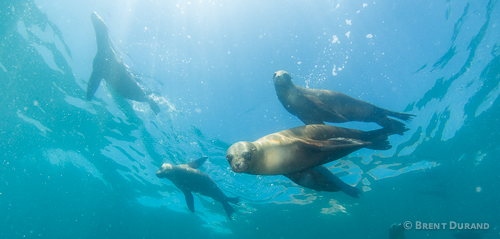Ikelite 5D Mark III Housing Review

Ikelite is known for producing great housings for underwater photographers on a budget – whether compact or DSLR. I’ve been diving with an Ikelite 5D Mark 3 housing for about 9 months: beach dives, a warm-water trip, the occasional boat or kayak dive and even a few sessions in California surf. The housing has performed really well in these conditions for macro, wide-angle and split shots. If you're not familiar with the Canon 5D Mark 3, check out Todd Winner's camera review.
As with all housings, adjusting camera settings is much easier with bare fingers than with gloves, however I’ve found no problems twisting the Ikelite knobs with 3.2 or 5.4 mil gloves. The main control dial takes a little practice with thick gloves but soon becomes second nature.

Basics
Attaching the camera to the Ikelite tray and opening/closing the housing is easy. The screw goes right into the camera's tripod socket and can be twisted by finger and then tightened with a wide flat screwdriver, coin or key. The latch system is very effective even when doused in sand. Changing lenses and ports with the camera in the housing is easy as well. The ports are attached with a 4-clasp system that is very sturdy underwater. I've used mine in breaking surf and rough beach entries over rocks with no problem (note: this is not recommended!). A benefit to Ikelite’s clear polycarbonate housing is that you can physically check the o-rings for any abnormalities after closing. Cleaning the o-ring grooves is very easy compared with other housings.
One of the negatives is that the housing doesn’t offer access to the joystick, which has two downsides. First, without access to the joystick you need to use the rear control wheel and main control dial to move the AF point around the frame, which is a slow process. Second, you cannot move around the screen when zoomed in during image review. This makes spotting backscatter on image sides or zooming in on non-center focal points tough.
For those using Ikelite strobes, the 5D Mark 3 housing offers full control of TTL exposure compensation via two buttons on the bottom right of the housing back – a really cool feature.


Specs
- Access to all important camera functions
- Capable of electrical TTL strobe exposure
- Comfortable rubber grips
- Glass optical viewfinder enhanced for underwater
- Visible o-ring seals
- Corrosion-proof solid body
- Ports available for most popular lenses
- Lens zoom gears included with housing
- 200ft (60m) depth rating
In the Water
I’ve been using the 5D Mark 3 with three lenses: the Canon 100mm Macro F2.8, Tokina 10-17, and Canon 17-40. The macro lens fits in Ikelite’s affordable macro port (no additional adaptors needed) and I use both the fisheye and wide-angle lenses in the 8-inch acryllic dome, although with different port bases.
Shooting Macro: The Ikelite 5D3 housing is great for shooting macro, both with the 100mm and with the 100mm plus a SubSee diopter and flip adaptor. One downside is that the strobes and arms are pulled in close to the housing, so sometimes when I’ve put myself in position for a shot I’ll need to drift up and away from the reef in order to reach around the strobe arms and twist the main control dial. This is the best way to avoid touching or damaging the reef if in a tight spot, but takes some extra time composing each frame. Higher-end housing controls are more ergonomic and this is a non-issue.

Shooting Wide-Angle: The Tokina 10-17 is hands-down the best fisheye lens for crop sensor cameras underwater and works very well on the 5D Mark 3 as long as focal length is kept between 15 and 17mm. I shoot the lens in Ikelite’s 8-inch dome and don’t bother with a zoom-ring, essentially creating a prime lens at 15 or 17mm (depending on anticipated subject). There are pros and cons to using an 8-inch dome vs. a 4-inch dome, but I chose the 8-inch because I shoot a lot of split-shots. The dome is slightly buoyant, however that’s an issue with any housing and acrylic 8-inch dome combo. Overall, the Ikelite housing works great for wide-angle and split shots.

Housing Maintenance
Maintenance is similar to every other underwater housing. It's ideal to soak the housing in water as soon as possible when exiting the water, as well as push all the buttons. I will also do warm water soaks without the camera in the housing in order to push the buttons in all the way and break up any salt buildup.
Pros
Great value for the price
Access to all important camera functions
O-rings & o-ring grooves very easy to clean and maintain
TTL functionality with Ikelite strobes
Easy switching of lenses/ports with camera in housing
Cons
No access to joystick on camera
Buttons require frequent maintenance to keep from sticking
Conclusion
This is a great housing for anyone wanting to house a 5D Mark 3 for about HALF the cost of any other housing. I enjoy the housing in every way (except for the few items I pointed out) and recommend it to anyone pursing great full frame images.

Further Reading
RECOMMENDED ARTICLES
SUPPORT THE UNDERWATER PHOTOGRAPHY GUIDE:
The Best Service & Prices on u/w Photo Gear
 Visit Bluewater Photo & Video for all your underwater photography and video gear. Click, or call the team at (310) 633-5052 for expert advice!
Visit Bluewater Photo & Video for all your underwater photography and video gear. Click, or call the team at (310) 633-5052 for expert advice!
The Best Pricing, Service & Expert Advice to Book your Dive Trips
 Bluewater Travel is your full-service scuba travel agency. Let our expert advisers plan and book your next dive vacation. Run by divers, for divers.
Bluewater Travel is your full-service scuba travel agency. Let our expert advisers plan and book your next dive vacation. Run by divers, for divers.



































